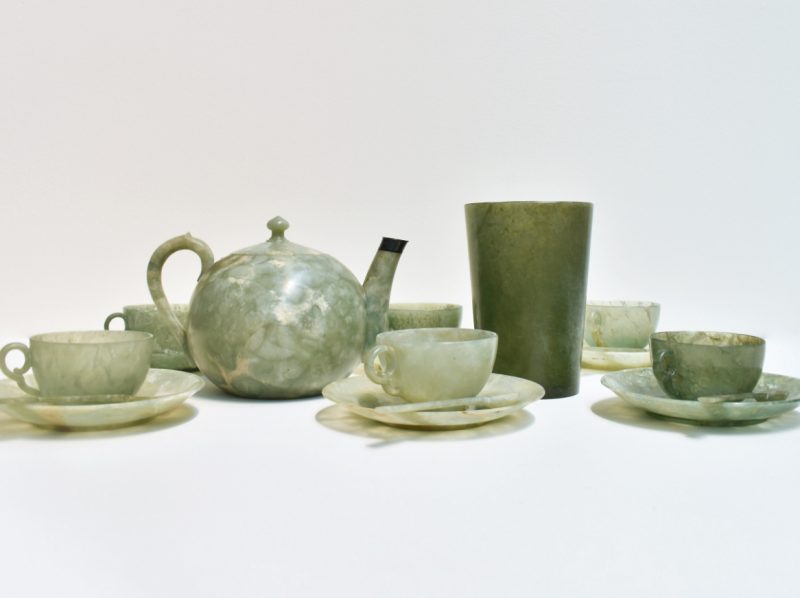This tea service belonged to William and Winifred Cavendish-Bentinck, the 6th Duke and Duchess of Portland. The set, now on display in our museum, was purchased by the couple in India.

Indian Jade Tea Set, 1902. © The Harley Foundation.
The service includes a teapot, six teacups, six saucers, six spoons, and a beaker, all carved from a false jade known as Bowenite. It was created by a craftsman from Bhera, a city that was once part of British India. Each piece is remarkably slender and delicate, a testament to his skill.
Our understanding of the tea set begins at the Delhi Durbar of 1903.
Delhi Durbar
Delhi Durbars were spectacles that celebrated the coronations of British monarchs in India. They involved elaborate ceremonies, exhibitions, sporting events, and processions demonstrating Britain’s power and imperial rule.
The Durbar of 1903 served to proclaim Edward VII Emperor of India. It was a grand event attended by the 6th Duke and Duchess of Portland.
In his memoir, Men, Women and Things, the Duke notes:
“I have not space to describe the Durbar itself, but it was a scene of the greatest splendour, organised in a wonderful way by Lord Curzon [the Viceroy of India] and the many able men who assisted him”.
The events lasted two weeks, so the Duke and Duchess stayed in a luxurious tented city that Curzon constructed just for the occasion.
It was at the extravagant Arts Exhibition that they procured the Bowenite tea set.
Arts Exhibition
Lord Curzon, the Viceroy of India, fervently admired Indian art. This inspired him to collect pieces from across the country, which he then displayed in his “Eastern Museum” in Derbyshire, also known as Kedleston Hall.
When organising the Arts Exhibition, Curzon had one purpose in mind: to spotlight the beauty of traditional Indian craftsmanship. To do such, he dispatched two assistants to travel across the country and find artists to showcase.

The Opening of The Indian Arts Exhibition by Bourne and Shepherd, 1902. © DAG Museum.
The Viceroy held the exhibition in an extravagant building he had erected at the Qudsia Bagh, a garden in Delhi (see above). At the opening ceremony, he stood at the entrance and gave a speech.
The Viceroy lamented the “progressive deterioration” of Indian handicrafts under British rule, seemingly ignorant of his role in this decline. He then announced his goal: “to show the world of what India is still capable, and if possible, to arrest the process of decay”.
Displaying authentic Indian art at the exhibition was central to his efforts. So, when preparing his assistants to select artists, Curzon gave very clear conditions. He asserted, “I would not have anything European or quasi-European in it”. This included “teapots, cream jugs, napkin rings, salt cellars, and cigarette cases”.
Despite Curzon’s strict stipulations, our Bowenite tea set found its way into the exhibition. But how could this be?
Mahomed Amin
Mahomed Amin was a skilled stonecutter from Bhera. He is the only artist accredited for creating Bowenite tea sets for the Delhi Durbar in the official exhibition catalogue, which leads us to believe he carved the service in our collection.
While Amin has been difficult to trace, we have learnt that he won a silver medal at the exhibition for his lapidary work and showcased a range of items:
- A Bowenite book rest (purchased by Curzon)
- Numerous Bowenite caskets (purchased by Curzon )
- A Bowenite surahi (water pot) and tumbler
- Two Bowenite tables inlaid with Purbeck marble
- A chess table inlaid with Bowenite and marble
- Two Bowenite sets of afternoon-tea services
As this inventory list suggests, Amin generally observed Curzon’s rules and crafted traditional Indian objects, which Curzon clearly admired. The only exception is the two tea services.
The Viceroy claimed that these pieces would have “crept in, because the process of Europeanisation [was] going on a pace” in India, erasing native art forms in its wake. But his viewpoint stamps out the agency of our skilled artist in a true colonial fashion. I instead would theorise that sneaking the tea sets into the exhibition was an act of defiance and genius on Amin’s part.
Amin had been selected to showcase his work at the Delhi Durbar, the most anticipated celebration that year, attended by British royalty, dignitaries, and officials. British consumers like these were readily commissioning Indian artists to make objects like teapots at the time. So, breaking Curzon’s rule and using the Arts Exhibition to display his elegant tea services would have proved very profitable for Amin.
As the Bowenite tea set was purchased by the 6th Duke and Duchess of Portland, it is clear that Amin knew his audience well.
Thus, while the tea set can be viewed as a testament to how British imperialism inevitably impacted the artistic output in India, it is more important to recognise the piece as the conscious creation of a skilled Indian craftsman.
My deepest appreciation to Dr Hannah Obee for sharing her insight on Mahomed Amin.
